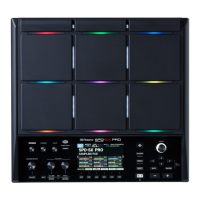Effect List (English)
194
Turns the amp switch on/off.
Amp Type
This models the sound of the Roland JC-120.
This models a Fender Twin Reverb.
MATCH DRIVE
This models the sound input to left input on a Matchless D/C-30.
A simulation of the latest tube amp widely used in styles from blues and rock.
BG LEAD
This models the lead sound of the MESA/Boogie combo amp.
The sound of a tube amp typical of the late ‘70s to ‘80s.
MS1959I
This models the sound input to Input I on a Marshall 1959.
This is a trebly sound suited to hard rock.
This models the sound input to Input II on a Marshall 1959.
MS1959I+II
This models the sound of connecting inputs I and II on a Marshall 1959 in parallel.
lt creates a sound with a stronger low end than MS1959I.
This models a Soldano SLO-100. This is the typical sound of the eighties.
This models the lead channel of a Peavey EVH5150.
This is distortion sound that is ideal for performances of heavy riffs.
OD-1
This models the sound of the BOSS OD-1.
This produces sweet, mild distortion.
This is the high-gain overdrive sound of the BOSS OD-2.
This gives a basic, traditional distortion sound.
A fuzz sound with rich harmonic content.
Volume and amount of distortion of the amp
Volume of the entire pre-amp
Amp Gain
Amount of pre-amp distortion
Tone of the bass/mid/treble frequency range
Tone for the ultra-high frequency range
Amp Bright
Turning this “On” produces a sharper and brighter sound.
* This parameter applies to the “JC-120”, “CLEAN TWIN”, “MATCH DRIVE”, and “BG
LEAD” Pre Amp Types.
Determines whether the signal passes through the speaker (ON), or not (OFF).
Speaker Type
Diameter (in inches) and number of the
speaker
Small open-back enclosure
Small open-back enclosure
Mic Setting
Adjusts the location of the microphone that is recording the sound of the speaker.
This can be adjusted in three steps, with the microphone becoming more distant in the
Volume of the direct sound
Stereo location of the output sound
*1: This parameter corresponds to MFX Ctrl. For details, refer to “De MFX bedienen met de PAD EDIT [1] [2]-regelaars (MFX
Ctrl)(P.204)”.

